#bat biology
Text
Lubee Bat Conservancy: "Actually, some native bat species vibrate when they are at rest and content"
Description: moderately loud music plays as a bat vibrates. **volume warning**
466 notes
·
View notes
Text
Thought I'd post something relating to another very long time running special interest - bats
It's currently bat appreciation month ♡
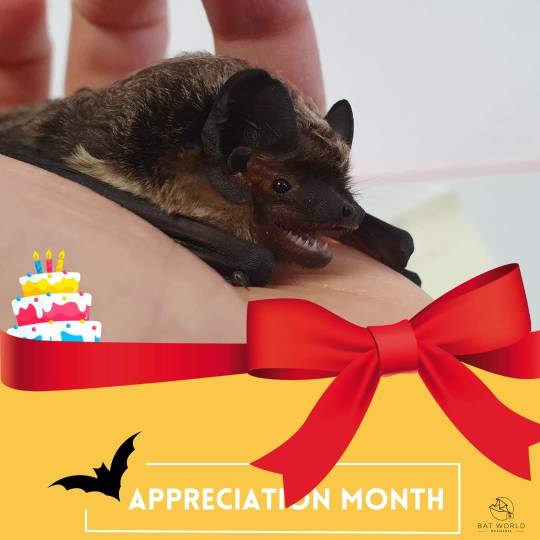
Posted by Bat World Sanctuary
#bat#bats#bat bio#bat biology#bat world sanctuary#bat appreciation month#nocturnal#mammal#zoology#biology
24 notes
·
View notes
Note
tell me about the bats

please?
Sure thing! I’ll tell you about some of the bats I caught with my biology professor (they weren’t harmed or killed, don’t worry).
(Side note, you need a permit to catch bats, so don’t try this at home, kids!)
First up, let’s talk mist nets! The nets my professor uses are actually meant for birds and are nearly invisible (especially at night) since the strands are so fine. However, bats can still actually see them with their echolocation! How do we counteract this? We put the nets over a stream or in a clearing that bats fly through so regularly that they don’t constantly echolocate because they’ve memorized their path, or they’re getting a drink of water and can’t echolocate with their mouth full. Then you carefully untangle them while wearing leather gloves (I used a crochet hook to help untangle them). You obviously must be gentle with them, especially their wings. The bats I was able to touch without gloves were as soft as a rabbit. Bats are typically very clean and groom each other as a way of bonding (though can still have mites, as many of the big browns did).
The most common one we caught, as well as the largest, was the big brown bat (Eptesicus fuscus), which has the nickname Eptesicus fuss-n-cuss because of how loudly they yell at you when you catch them. These bats only weigh about as much as a car key, and the females are larger than the males. They have big teeth for crunching beetles. These ones also find their way into buildings frequently and are around humans more than some of the other species I caught.
Big Brown pictured below (not my pic)
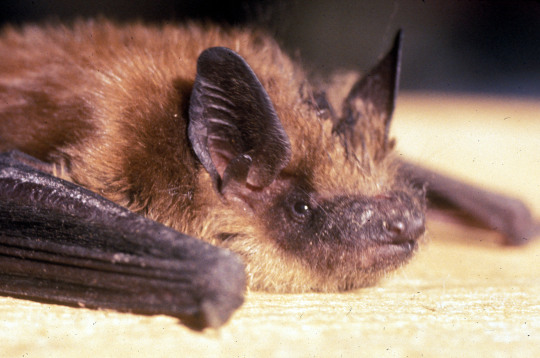
Eastern red bats (Lasiurus borealis) are such pretty bats; they look like Halloween with their orange fur and black wings. Their fur is designed for cooler weather, even having fur on their wings. They’re related to the hoary bat and look similar, though much smaller and redder. We didn’t catch any hoary bats since they fly higher than the nets go, but a cool fact about them is that their echolocation actually can be heard by some humans. It’s just on the threshold of frequencies we can pick up, so some people still can’t hear it.
Eastern Red on left, Hoary on right (not my pics)
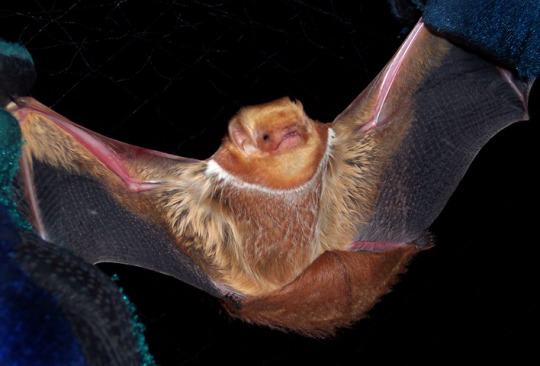
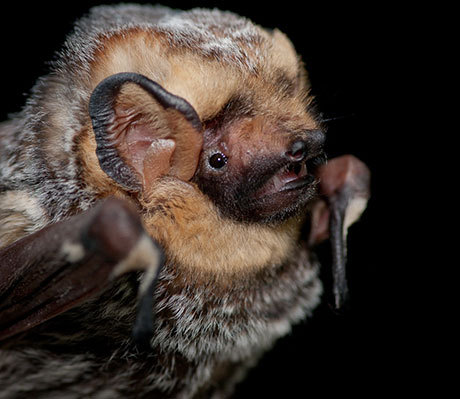
Evening bats (Nycticeius humeralis) look like smaller big brown bats, but you can easily tell them apart by smell. They have a distinct “burnt oranges” smell.
Evening bat (not my pic)

Little brown bats (Myotis lucifugus) have long hairs on their toes, so my professor likes to compare them to hobbits. They, like others in the genus Myotis, have a distress call that draws in other Myotis species (such as Indiana bats and Northern long-eared bats), so if you catch even one Myotis, you’re bound to get several more all in the same area of the net.
Little brown (not my pic)

Other fun facts: The shape and size of a bat’s wings determine its speed. Some bats are very fast, and others (such as those that eat spiders or caterpillars) can slowly hover.
When releasing a bat, you can’t put it on the ground, as they have a hard time getting off the ground. Instead, you toss them in the air so they can fly away. Alternatively, you can place them on a tree trunk, and they’ll sit there or climb a little higher before letting go to fly. This is also why they hang upside down, so they can just drop and go. Not many bats can jump—I know vampire bats can, but still not very high. However, don’t pick up a bat you’ve just found on the ground. Although I not nearly as many bats carry rabies as people often think, rabid bats will often wind up on the ground, so it’s best to leave them be.
To tell if a bat is an adult or juvenile, we hold their wings up to the light and check a joint in the arm part of their wing. If it’s clear, that means it still has cartilage, so it’s a juvenile. Adults will have solid bone, so it won’t be transparent.
Thanks for asking about bats!
#bat facts#bat biology#bats#inbox asks#mine#biology major talks about bats she studied because she’s a HUGE NERD :P
41 notes
·
View notes
Photo
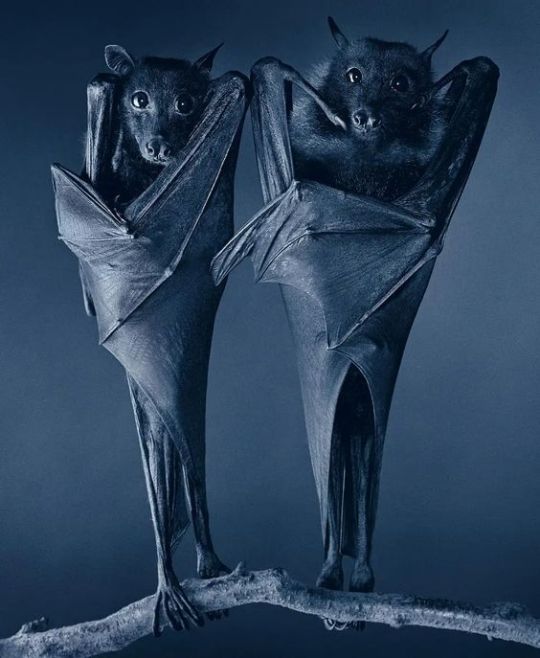
I recently read a book about bats by Merlin Tuttle, a Bat Biologist. I watched him on Joe Rogan’s podcast and it was fascinating! Learnt so much about bats and how amazing they are! Check out the links below, if you are interested to learn more about bats.
Podcast highlights
The Secret Life Of Bats book
#bats#the secret life of bats#bat biology#secret life#secrets#magical#mysterious#merlin tuttle#adventures#biology#animal kingdom#love#planet#darkness#dark
41 notes
·
View notes
Text
I am a fan of the Bat!Eddie trope I just can never decide what species of Bat to make him or have him be a demoBat of some kind.
I know most folks have him as either a mega!bat like a flying fox or golden crowned flying fox (my personal fav)
But I also can see him as a microbat!
Like a vampire bat (they are so stupid their digestive system makes me want to scream, biology is fun kids) or a little brown bat or Indiana brown bat . Or a greater brown bat ?
Or perhaps a fisher!bat they eat fish and other bats .
Or or maybe he’s a demobat/bat of some kind ? Either way he’ll still eat flesh lol.
What do y’all think? You got any suggestions ?
#{isims}#bat biology#fun fact the mun is a biologist sooo ye#vampire bat#megabats#microbats#just him squeaking constantly is cute#while he’s trying to actively eat your face#vampire eddie munson#what do y’all think?#stranger things
12 notes
·
View notes
Text
EEEEEEEE EEEEEEEEE EEEEEEE
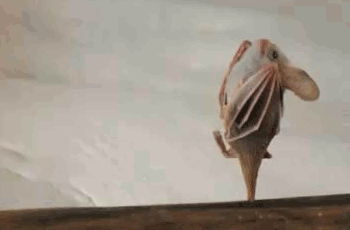
That's right! It's International Bat Appreciation Day! We share our planet with over 1400 species of bat, making the second most abundant mammal order, and they perform a wide variety of ecological roles, from dispersing seeds to pollinating flowers to eating thousands of insects in a single night! Over 200 bat species are listed as Threatened by the International Union for the Conservation of Nature--that is over 14 percent of all bats!
YOU can help endangered bats today by donating to Pennsylvania Bat Rescue at this link. This PA-based organization rehabilitates sick or injured bats and helps educate people like you and me in how we can create more bat-friendly environments.
If you want to learn about particularly-cool bat species native to New Zealand, check out this Consider Nature article on the Pekapeka, the bat that walks:
For the rest of the day, Consider Nature will be bat-bombing Tumblr with some of our favorite bat species to share them with the world!
Alt text: a small brown bat stretching its wings with the kind of fabulous flourish that would impress Ryan Evans.
#animals#nature#science#biology#wildlife#conservation#environment#bats#international bat appreciation day#batbombing
4K notes
·
View notes
Text


"The common bat (Bat bat) is a small bat microbat"
this bat is the most bat of any bat ever

absolute maximum quantity of bat in this guy
7K notes
·
View notes
Text
Animal of the Day!
Honduran White Bat (Ectophylla alba)
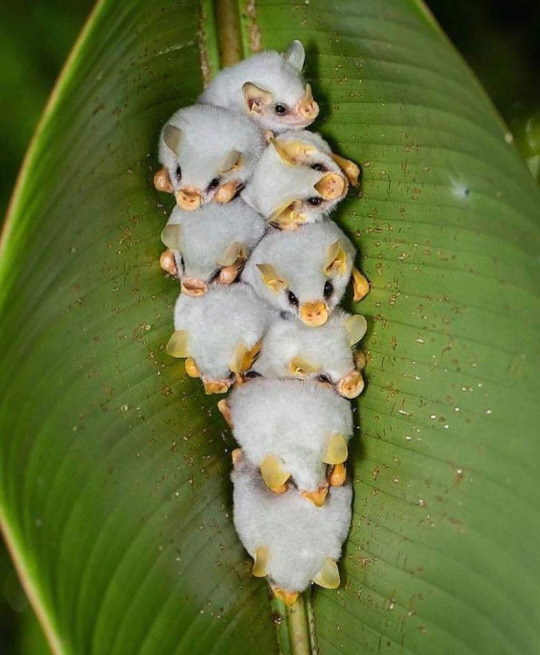
(Photo from WordPress)
Conservation Status- Near Threatened
Habitat- Southern Central America
Size (Weight/Length)- 4.5 cm
Diet- Fruit
Cool Facts- The leaf-cuddling Honduran white bat made quite the rounds on the internet due to their adorable sleeping arrangements. During the day, these bats group together in ‘tents’ made out of leaves by cutting them open in the midrib with their teeth. The tents are constructed by multiple bats and are lived in for multiple weeks until the leaf dies. Colonies usually consist of 1-15 individuals and their offspring. The leaves give further protection from predators by making the Honduran white bat’s fur appear green when sunlight casts onto the leaf. These bats feed almost exclusively on figs. The yellow carotenoids in the fruit result in the yellow coloration on the bat’s nose and ears, resulting in the Honduran white bat being one of the only mammals to have coloration based on their diet.
Rating- 14/10 (Baby bats are called pups. Bat puppies.)
#animal of the day#animals#mammals#bats#thursday#september 14#honduran white bat#biology#science#conservation#the more you know
560 notes
·
View notes
Text
Taxonomy Tournament: Mammals
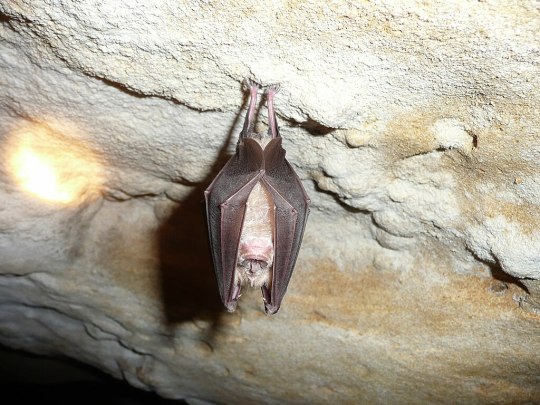

Chiroptera. This order is made up of bats, the only mammals capable of self-powered flight. It is the second-most speciose order of mammals, with over 1400 species.
Rodents. This order is characterised by having a single pair of continuously-growing incisors. 40% of mammal species are rodents. Examples include rats, mice, beavers, capybaras, squirrels, and chipmunks.
#animals#biology#polls#poll tournament#zoology#bats#mammals#tetrapods#rats#mice#beavers#capybaras#squirrels#chipmunks#Chiroptera#Rodents#0x0v0x3f
196 notes
·
View notes
Text
Daily fish fact #553
Chinese high-fin banded shark!

Can also be called bat loach, Chinese sailfin sucker or just Chinese sucker. They're occasionally kept in aquariums, but as they grow to be over half a meter long, they aren't fit for just about any aquarium. It's the only sucker species found in China!
#fish#fish facts#fishfact#fishblr#biology#zoology#chinese highfin banded shark#chinese high-fin banded shark#bat loach#chinese sailfin sucker#chinese sucker
200 notes
·
View notes
Text
While the new finding comes from a small sample of one bat species, “I have no doubt that this is more widespread,” [Nicolas] Fasel says. The behavior likely occurs among other bats whose females have a similar tail membrane, [Teri] Orr says. Beyond the “gee-whiz” factor, these findings reveal important gaps in researchers’ knowledge about bat reproduction, she adds. “Bats are such a poorly understood group, and they tend to be vilified,” Orr says. “At the end of the day, if we don’t understand their reproductive biology, we’re going to be really challenged when it comes to conservation.”
39 notes
·
View notes
Text
Grote's Bertholdia Moth: when bats are detected nearby, these moths emit a rapid series of ultrasonic clicks that act as a "jammer," interfering with the bat's sonar signals so that the moth can avoid detection

The Grote's bertholdia moth (B. trigona) is capable of emitting about 4,500 ultrasonic "clicks" per second. While there are other types of moths that use ultrasonic signals (in various ways) to avoid being preyed upon by bats, none of them have a more rapid-fire pace than this species.
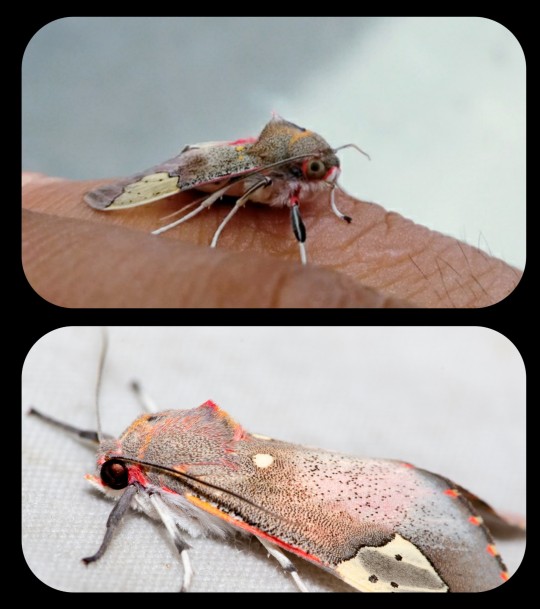
The barrage of signals provides the moth with a way to remain hidden, because it interferes with the echolocation that bats use to navigate and locate prey.
As this article from Smithsonian explains:
... when approached by the bats, the moths produced their own ultrasonic clicking sounds at a rate of 4,500 times per second, blanketing the surrounding environment and cloaking themselves from sonar detection.
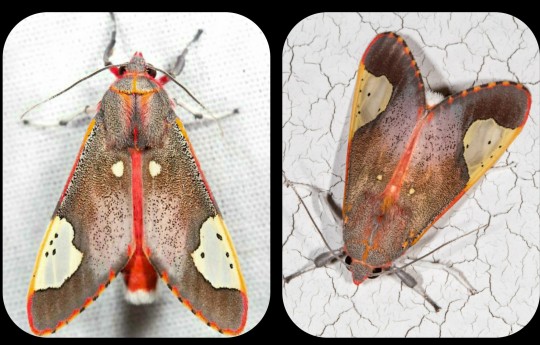
This article also expands upon the use of ultrasonic signals among moths:
Like other nocturnal insects, moths need to contend with bats. Unlike grasshoppers or beetles, they have soft bodies without spines or hard cuticles to protect them. Yet bats’ reliance on echolocation has given moths a way to avoid ending up as food: by tapping into their predators’ acoustic signals. Many have evolved ears that can hear the calls of bats. Some moths make ultrasonic squeaks, chirps, or clicks to warn their predators (honestly or not) that they are poisonous. Others generate near-constant, ultrasonic buzzes capable of jamming bat sonar.
Sources & More Info:
Smithsonian Magazine: How One Moth Species Can Jam Bats' Sonar Systems
The Scientist: Many Moths Speak Up to Ward Off Bats
Science.org: Moths Block Bats' Sonar
PubMed: High Duty Cycle Moth Sounds Jam Bat Echolocation
Journal of Theoretical Biology: Neural Representation of Bat Predation Risk and Evasive Flight in Moths
#moth#lepidoptera#biology#grote's bertholdia#Bertholdia trigona#adaptation#evolutionary arms race#bats#nature#echolocation#cool bugs#tw insects#ultrasonic animals#arthropods#bugs#weird animals
153 notes
·
View notes
Text
i love investigating about the convergent evolution of wings bc it opens up so many possibilities. last night I was reading about the hypothetical designs for primitive bats, these freaks (affectionate)

cool, right? and in the article I was reading they included a video showing bats catching and eating moths mid-air. here's the link for everyone. in the video, we can obviously hear them using echolocation, but what's interesting is how they catch the insects. I was under the impression that they captured them with their mouths, and although they do it sometimes, the majority of times they actually do it with their wings! like some kind of second hand!
the article explained that these primitive bats hanged upside-down from tree branches to use their advanced sense of hearing for detecting insects. when they heard a nearby bug they opened their membraned limbs and rapidly catch their prey. with time, this membrane would get bigger and bigger, as bats with this characteristic could hunt more bugs and be more efficient, thus reproducing more often and passing those genes for the next generation. evolution did its thing, and with enough time, the membraned limbs would get big enough so that the animal could glide from high distances and, eventually, fly.

and oh my god this changes EVERYTHING. I was struggling to find a reason why dragons could've kept their six limbs (2 hands, 2 feet and 2 wings) when the answer was so obvious. of course, they use them to hunt!
so why do dragons have wings? or, more specifically, how did wings evolve in dragons? the answer is not so easy. we've established that wings were initially used for hunting, yes, but why the extra limbs? why not have just four limbs, two of whom are used to fly? easy: they need those four limbs (hand and feet) for something else. I've thought about it and came to the conclusion that dragons, in their most primitive form, were climbing creatures. their environment could be an island with mountains and sharp cliffs, and prey could make nests or burrows in these cliffs. this forces dragons to climb almost vertical walls to hunt, restricting them to use their extra limbs to catch prey because their hands and feet would be occupied with the climbing. hundreds of thousands of years of natural selection later, and you have creatures that no longer need to climb, because their wings allow them to maintain themselves in the air for long periods of time: dragons.
I've yet to make a phylogenetic tree for the genus, when I finish it I'll post it in a reblog later today or tomorrow morning.
#this is not just my sandbox i live here#i put the speculative in biology#dragons#speculative biology#evolution#bats#science
308 notes
·
View notes
Text

Taxidermy black-eared flying foxes
By: Unknown photographer
From: Handbuch der Biologie der Wirbeltiere
1913
#taxidermy#black-eared flying fox#megabat#bat#mammal#1913#1910s#Handbuch der Biologie der Wirbeltiere
164 notes
·
View notes
Text
*crashes through wall like the Kool-Aid Man*
Y'ALL GOTTA LEARN ABOUT THIS COOL-ASS BAT
2K notes
·
View notes
Text
Alteration of small areas of the human genome can have drastic effects. Inducing the expression of the BAR116 region of the HoxD genes induces body differentiation only seen in the highly specialized mammal limbs of bats and colugos. Examples like this one are rare but notable.

720 notes
·
View notes